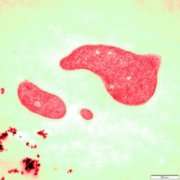An electron micrograph image of Ferroplasma acidiphilumi
New light has been shed on the microbial life living in extreme environments. Research by Professor Peter Golyshin of Bangor University, and an international team, published in the prestigious scientific journal, Proceedings of the National Academy of Science of the U.S.A., reveals more about how a microbe living in an extreme environment maintains DNA integrity.
Unlike any other organism yet discovered the protein responsible for DNA repair and replication (DNA ligase) in a remarkable organism that thrives in extremely acidic conditions (Ferroplasma acidiphilum) is iron-based. Similar proteins in other organisms rely on magnesium or potassium as elements required for their activities. The enzyme from Ferroplasma binds iron atoms which gives this protein a beautiful purple colour.
The protein isolated in Professor Golyshin's lab is unusual. In an extreme acidic environment one would expect the DNA blueprint for cell replication to become damaged and mutated. The presence of iron acts against this. The iron-containing molecules are the building blocks for DNA molecules- they are, according to Professor Golyshin, "the 'iron rivets' that hold the proteins together; ensuring the correct replication and recombination of DNA and repairing breaks in the DNA. The biochemical 'machinery' of the organism depends on these 'iron rivets' within the proteins."
"This tells us a great deal about life in extreme environments- which is important when you consider that many speculate that life on earth began in such 'hostile' conditions- in the early stages of life on Earth; there was an abundance of iron-sulfur rich minerals and a great abundance of soluble iron in the environment. This new knowledge about this iron-dependent organism substantiates that speculation about early life on our Planet, showing the DNA can effectively be repaired under extremely acidic conditions, at pH 1.5-3" explains Professor Golyshin.
"This work will have an impact on our understanding of how key enzymatic activities could have emerged in the iron-rich scenario that dominated the onset of Life on Earth," says Professor Victor de Lorenzo from the National Centre for Biotechnology in Madrid (Spain). "I would not be surprised to see these findings reflected soon in mainstream textbooks in microbiology and biochemistry."
The organism at the heart of this study, Ferroplasma, was discovered in a bioreactor operating with pyrite ores. This organism is a part of microbial communities applied in bio-metallurgy to extract metals from the ores. In nature, it can be found in acidic and iron-rich environments, often in the areas of hydrothermal and tectonic activities.
Source: Bangor University
























